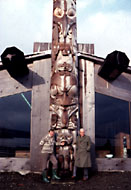| IN MEMORIAM: | (1920-1998) |
Biographical Notes
Upbringing and apprenticeship | Early work | Monumental works
Words and pictures | Bill Reid, 1920-1998 | His legacy
Early work
"Reid's work as a whole seems to single out and emphasize that fundamental quality of traditional Haida art, so that even his 'non-traditional' pieces may evoke the Haida spirit, a civilizing and humanizing spirit of self-discipline in the face of tremendous energy, a love of structure and order over arbitrary waywardness and release, and a passion for elegance, precision and refinement."
Joan Vastokas, "Bill Reid and the native renaissance," Artscanada, nos.198/199 (June 1975), p.16"I think the dialogue between me, a product of urban twentieth-century North American culture, and the conventions of nineteenth-century Haida artistic expression, has produced some quite remarkable objects."
Bill Reid, quoted in Karen Duffek, Bill Reid: Beyond the Essential Form, Vancouver: University of British Columbia Press, 1986, p.3
By now, Reid was working full-time as a craftsperson, with a small jewellery business. His knowledge of Northwest Coast Native art led to his engagement as a consultant, from 1965-67, to assist Wilson Duff and Bill Holm in preparing the exhibition "Arts of the Raven", as the Vancouver Art Gallery's Centennial project; in the process he and Holm were sent to examine museum and private collections all over North America. This exhibition was important for treating Northwest Coast artifacts as high art, rather than ethnological objects; some of Reid's own pieces were shown. They included a decorated bentwood box which Reid had copied from a box in the American Museum of Natural History; he considered the nineteenth-century original a masterpiece and referred to his effort to learn from it as "the final exam" in understanding the visual language of Haida design. Other centennial projects led to his first gold box, for the Canadian pavilion at Expo 67, and a large cedar screen for the new building of the Royal British Columbia Museum.
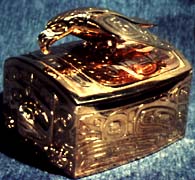 |
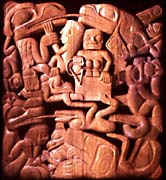 |
|
| gold box (1967) | Legacy (1968) Royal British Columbia Museum cat.no.16639 |
Receiving a Canada Council Senior Grant in 1968, he was able to spend a year at the Central School of Design in London, England, studying Northwest Coast collections in Europe and improving his goldsmithing techniques. After his return, and seeking a change of scene, he spent three years working in Montreal. It was in this four-year period that he produced some of the finest pieces of his early career, including what he long considered his best work, "Raven Discovering Mankind in the Clam Shell", a three-inch boxwood carving (1970) inspired by an Edenshaw argillite dish, and the similarly sized and almost equally acclaimed bear-shaped gold dish topped by the Bear Mother suckling her cubs. The Raven was significant to Reid, not only as the culture-hero of Haida mythology and a particular focus of attention for Edenshaw, but also for the ability to transform inanimate material into dynamic forms -- a metaphor for the artist. His many artistic characterizations of the Raven he claimed to have created in his own image. Ten years later he, with the assistance of other sculptors and carvers, completed a huge yellow cedar version of the 1970 miniature for the collection of the UBC Museum of Anthropology. Entitled "The Raven and the First Men" it was probably his best-known work before "The Spirit of Haida Gwaii" excited attention worldwide.
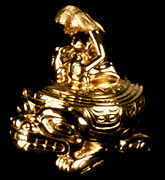 |
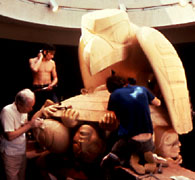 |
|
| gold dish (1972) Canadian Museum of Civilization VII-B-1574 a,b (S73-1115) |
Working on The Raven and the First Men |
Also among his most celebrated creations is a traditional Haida pole which he designed, carved and installed in 1978 in front of the new Band Council building at Skidegate, his mother's village, on a site once occupied by his grandfather's workshop. The many nineteenth century poles that had once graced the village had been cut down at the instigation of Christian missionaries; only one remained in 1978, and that decaying. Consequently, the pole became for local aspiring carvers a powerful statement about the refusal of Haida culture to die, although Reid said that his personal purpose was only to memorialize the ancestors of Skidegate's inhabitants and to ensure that the village was not without a pole. At a huge potlatch to mark the pole-raising and to thank Reid, he was presented with a ceremonial button-blanket -- a high honour.
Reid always considered the notion of his central role in a "Haida renaissance" as exaggerated; he was more inclined to credit the preservation of many examples of Haida art in museums, and the restoration and replication efforts these enabled, such as those on which he personally worked in the 1950s. Nonetheless, he is credited with rediscovering the basic aesthetic vocabulary of Haida art -- the tapered formline which can be bent into a U-shape or curved into an ovoid -- and of passing on what he learned to a new generation of artists. These conclusions arrived at intuitively by Bill Reid were also reached by Bill Holm through analytical study of artifacts and became part of his published codification of the design principles that are integral to Northwest Coast Native art. The two men shared their insights in the book "Form and Freedom", published (1975) in association with an exhibition mounted at Rice University.
 |
 |
 |
